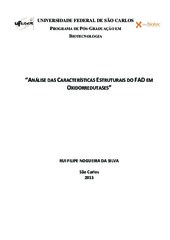| dc.contributor.author | Silva, Rui Filipe Nogueira da | |
| dc.date.accessioned | 2016-10-05T19:07:51Z | |
| dc.date.available | 2016-10-05T19:07:51Z | |
| dc.date.issued | 2015-08-11 | |
| dc.identifier.citation | SILVA, Rui Filipe Nogueira da. Análise das características estruturais do FAD em oxidorredutases. 2015. Dissertação (Mestrado em Biotecnologia) – Universidade Federal de São Carlos, São Carlos, 2015. Disponível em: https://repositorio.ufscar.br/handle/ufscar/7704. | * |
| dc.identifier.uri | https://repositorio.ufscar.br/handle/ufscar/7704 | |
| dc.description.abstract | In this work, oxidoreductases of the glutathione reductase (GR), trypanothione reductase (TR) and sulfhydryl oxidase (SOX) sub-subclasses that are FAD (flavin adenine dinucleotide) dependent enzymes and contain a group with sulfur as a charge acceptor/donor near the FAD isoalloxazine region were studied. Oxidoreductases are enzymes capable of catalyzing redox reactions, thus requiring donor groups and acceptor groups of charges. FAD is a cofactor of the oxidoreductases and participates in the enzymatic catalysis, brokering the transfer of charges between ligands and the polypeptide chain of the proteins. The thiol groups and disulfide bonds existing in the enzymes are, in many instances, involved in these transfer of protons and electrons together with the FAD. The conformation of the isoalloxazine region of the FAD and the π interactions between the sulfur atoms and the flavin region were studied. The crystal structures of 180 oxidoreductases with FAD and disulfide bonds retrieved from the Protein Data Bank (PDB) were analyzed, which allowed to set up some relationships between the bond lengths of the disulfide bridge in proteins and in small molecules, to determine the existence of deformations of the isoalloxazine moiety of the FAD, to measure the SG-π interaction distances and realize some FAD features that help differentiate the GR, TR and SOX sub-subclasses. | eng |
| dc.description.sponsorship | Conselho Nacional de Desenvolvimento Científico e Tecnológico (CNPq) | por |
| dc.language.iso | por | por |
| dc.publisher | Universidade Federal de São Carlos | por |
| dc.rights.uri | Acesso aberto | por |
| dc.subject | Biotecnologia | por |
| dc.subject | Glutationa redutase | por |
| dc.subject | Oxidorredutases | por |
| dc.subject | Tripanotiona redutase | por |
| dc.subject | FAD | por |
| dc.subject | π interactions | eng |
| dc.subject | Dissulfide | eng |
| dc.subject | S-π | eng |
| dc.subject | Oxidorreductases | eng |
| dc.subject | Glutathione reductase | eng |
| dc.subject | Trypanothione reductase | eng |
| dc.subject | Sulfhydryl oxidase | eng |
| dc.title | Análise das características estruturais do FAD em oxidorredutases | por |
| dc.type | Dissertação | por |
| dc.contributor.advisor1 | Caracelli, Ignez | |
| dc.contributor.advisor1Lattes | http://lattes.cnpq.br/8956527354576143 | por |
| dc.contributor.advisor-co1 | Schpector, Julio Zukerman | |
| dc.contributor.advisor-co1Lattes | http://lattes.cnpq.br/4252331837170383 | por |
| dc.description.resumo | Neste trabalho foram estudadas oxidorredutases das sub-subclasses
glutationa redutases (GR), tripanotiona redutases (TR) e sulfidril oxidases
(SOX) que são enzimas dependentes de FAD (flavina adenina dinucleotídeo) e
contêm um grupo com enxofre como aceitador/doador de cargas, próximo à
região isoaloxazina do FAD.
As oxidorredutases são enzimas capazes de catalisar reações redox,
necessitando, para tal, de grupos doadores e grupos aceitadores de cargas. O
FAD é um cofator das oxidorredutases e participa na catálise enzimática,
intermediando a transferência de cargas entre ligantes e a cadeia polipeptídica
das proteínas. Os grupos tiol e as ligações dissulfeto existentes nas enzimas
estão, em muitos casos, envolvidos nessas transferências de prótons e elétrons
em conjunto com o FAD.
Foi realizado o estudo da conformação da região isoaloxazina do
FAD e de interações π entre os átomos de enxofre e a flavina do FAD.
Foram analisadas 180 estruturas cristalográficas de oxidorredutases
com FAD e ligações dissulfeto obtidas do Protein Data Bank (PDB) o que
permitiu relacionar os comprimentos da ligação dissulfeto em proteínas e em
pequenas moléculas, classificar deformações da isoaloxazina do FAD,
determinar distâncias de interação SG-π e perceber caraterísticas do FAD que
permitem diferenciar as sub-subclasses de GR, TR e SOX. | por |
| dc.publisher.initials | UFSCar | por |
| dc.publisher.program | Programa de Pós-Graduação em Biotecnologia - PPGBiotec | por |
| dc.subject.cnpq | CIENCIAS EXATAS E DA TERRA::FISICA | por |
| dc.subject.cnpq | CIENCIAS EXATAS E DA TERRA::QUIMICA | por |
| dc.description.sponsorshipId | CNPq: 166636/2013-4 | por |
| dc.ufscar.embargo | Online | por |
| dc.publisher.address | Câmpus São Carlos | por |
| dc.contributor.authorlattes | http://lattes.cnpq.br/7774465367894278 | por |
